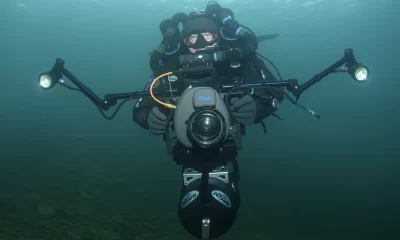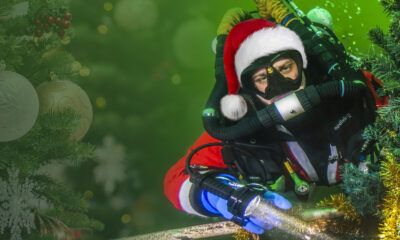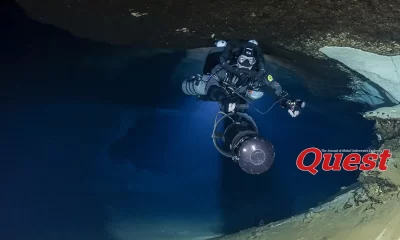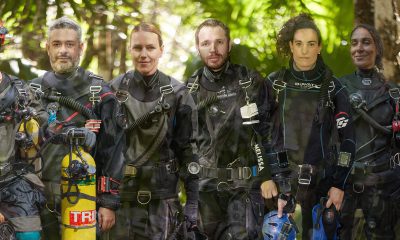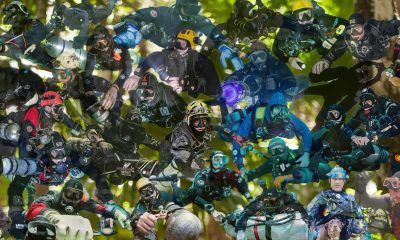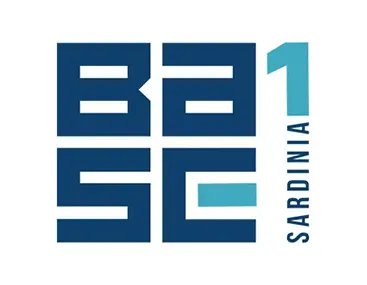Community
The Who’s Who of Sidemount

Jeff Loflin
Jeff Loflin was one of the first international ambassadors for sidemount diving and was instrumental in helping to bring sidemount diving to the open water tech and recreational communities. With nearly 40 years of teaching experience, the veteran educator is a trimix, cave and wreck diving instructor trainer for PADI, IANTD, TDI, and the NSS-CDS, where Jeff has served as chairman, treasurer and a director, and remains active training divers and instructors. A former commercial diver, Jeff is also a Public Safety Diver (PSD) and Emergency Response Diving International (ERDI) instructor trainer, and serves as a PADI Instructor Examiner. Based in Bonifay, Florida, he serves as the Diving Safety officer for the Florida Department of Environmental Protection (DEP).
Interview by Michael Menduno
What is sidemount to you?
I think sidemount diving is another way to enjoy the underwater world. It enables you to put your tanks, of course, conveniently on your side, and it gives you a safety zone because you’re able to see your regulators on both sides. Sidemount diving also gives you redundant air, and it allows you to see all my hoses and leak points and avoid being concerned that you’ll run out of gas. And, it’s a lot of fun because it’s a different way to dive and a way to learn new techniques while diving.
You were a PADI course director, and then got started in tech diving when PADI came out with their program in 2001.
That’s correct. I became a PADI instructor in 1983, and a course director in 1988. Then PADI started their Tec program in 2001, and I embraced it. I became a tech diver and then a tech instructor with PADI and IANTD. I also got cave certified with the National Speleological Society-Cave Diving Section (NSS-CDS). I wanted to do more in the cave diving world and become an instructor.
Ha! You went all in. I can relate. I remember, back in the day we used to say, if you want to become a tech diver you should take a cave diving course! So, how and when did you discover sidemount?
It was 2004. I was diving with Bill Rennaker, and I decided to take the sidemount certification course with him. At the time, I had been working with Edd Sorenson of Cave Adventurers who was already diving sidemount and mentoring me. I was also starting to teach overhead diving.
The standards in the overhead diving community were such that to teach a cavern, intro to cave, or full cave, you had to do it in a backmount gear configuration. Sidemount was a specialty area: you had to be certified as a full cave diver, and have X number of dives in sidemount; then you would take a specialty program for sidemount. As I mentioned, I was teaching for Cave Adventurers in backmount and Edd, who was already diving sidemount.
I ended up having a skydiving accident in 2005 that caused me some major damage to my right ankle. I was in some rehab from 2005 up into 2006, and my doctor warned me about putting a lot of weight on my ankle walking with doubles.
OUCH! No doubles?!? That could put a dent in your tech career. What did you do?
After recovering from my accident, I organized a family dive trip to Bonaire. At the time, my daughter had just completed Marine Corps boot camp, and we were on vacation with friends to celebrate her graduation. Edd and his partner Stacey joined us. Edd was diving sidemount in the open water, and it struck me how easy it was, just like in cave world, and I thought, this is a great idea!

When I came back from that trip in 2006, I started working with some folks around here involved in sidemount. Edd was one, Lamar Hires was another and there were three or four others. I wanted to adapt what we were using in the overhead world and bring it out into the open water world.
Especially for me with my ankle, being able to drop single tanks at the water’s edge and wear them on my side made a huge difference.
So, in 2008, I submitted and got approval for a PADI distinctive specialty in both sidemount diving, as well as distinctive specialty in sidemount instructor.
A distinctive specialty means that you can teach it to your students, but it’s not a PADI course available to everyone. Is that right? How about the distinctive instructor specialty, what was that?
That’s correct. The distinctive specialty isn’t a standalone course with PADI or other diving agencies; it’s something that you author. PADI reviews the course for educational content and for safety purposes. Then, if it meets their criteria, it is approved.
The distinctive instructor specialty enabled me to teach the PADI Tec program in sidemount, which historically was conducted in back mounted doubles. I demonstrated that it worked well and there were no issues. Then, in the second quarter of 2009 training bulletin, PADI announced that you could teach their Tec program in sidemount if you were a sidemount instructor. Two quarters later, they released an update enabling sidemount instructors to teach the PADI cavern program in sidemount.
Did you get push back in the community for bringing the program to recreational divers?
There was a group that believed that sidemount only belonged in caves, specifically the ones with small restrictions and or sumps where you typically can’t use back mounted doubles. From others, the opinion I got was definitely positive. Many were excited that something new and innovative was about to be available. Something that had been exclusively in the cave diving world, and really wasn’t that difficult. My experience has been that my students’ responses were very positive. I liked to say that we were taking sidemount from the dark and bringing it into the light.

I get it for tech of course. But why would recreational divers want to go sidemount?
According to a survey we did, the number one reason people go sidemount is for safety and security. The thing that recreational scuba divers are most afraid of is running out of gas. That’s why Spare Air became so popular! Having two tanks is a big safety factor. Also, there is no “detective work” involved. You can see your regulators and gauges—we teach divers how to feather their valves for example, if a hose breaks for example. And of course, there are divers with physical challenges, like me. Finally, it’s viewed as a stepping stone to tech.
That makes good sense! I would have found it appealing in my recreational days. And my back, well that’s another story. You know, Edd told me he was stoked when you created the specialty. He said, “PADI is the biggest dive organization in the world and if they adopt this, sidemount is going to spread worldwide!”
I should note that at that time I heard that there were several other instructors who had authored their own sidemount specialty outlines. So, we had a distinctive specialty at that point, and I started looking for manufacturers to help. What we needed was gear that would be suitable for the recreational world and tech. One of the issues was having a dual bladder BCD.
In order to have a redundant buoyancy source for wetsuit divers?
Exactly. That was a requirement in the PADI Tec programs. So, I reached out to the manufacturers that were looking into that, one was OxyCheq, another was OMS, and of course Dive Rite. We were interested in creating a sidemount configuration for open water diving, and much of it would likely be done in wetsuits.
In 2008, I went to DEMA, and again, I was looking for manufacturers to work with the sidemount system. I met with Nick Hollis and talked to him about sidemount. He said they would consider it. Meanwhile I was actively involved in teaching my distinctive sidemount specialty and teaching Tec classes.
Then in 2009, I met with the Hollis family again at DEMA in Orlando, and Bob Hollis invited me to address both his staff and distributor for their company, American Underwater Products (AUP). The room was packed. Later I took Nick and some others in the pool and let them try out the sidemount gear configuration I was using. At that DEMA, Bob decided that they would get behind recreational open water sidemount and manufacture a sidemount system.
The following year Hollis released their SMS 100. It resulted in a big boost for my personal diving career. Bob said that we needed to go to AUP’s dealers and distributors around the world and show them this new product. So, I traveled with the Hollis/AUP staff and made presentations all around the world, including Russia, the UK, Australia, Germany, Brazil, South Korea, the Caribbean, the US, Canada, and I’m sure there are others..
That’s amazing. You arguably became one of sidemount’s first ambassadors!
That next year was one of the highlights of my 39 years of teaching scuba. Bob asked me if I would take him and his family to Mexico and dive the SMS 100 that his company had designed. It was a real privilege for me. We went to Playa del Carmen, and I had the opportunity to actually Bob, Nick and Mike Hollis diving in sidemount. That was a very memorable experience.

I bet! Wow. It seems that the launch of SMS 100 was certainly an inflection point in the growth of sidemount.
In my humble opinion, our initiative with Hollis really helped pique interest in recreational sidemount. And remember, other companies like Dive Rite, which had been making sidemount gear for years, was also promoting it. As you well know, sidemount wasn’t new, it had been around in the cave community for decades prior to my getting involved, but it wasn’t really common in the recreational open ocean or open lake arena until Hollis started pushing it. That increased awareness of the fun and excitement of sidemount. It was something different and didn’t require a lot of new gear, like with rebreathers.
As you would expect with all the interest, a lot of instructors like myself authored some sidemount programs with PADI, and many took the instructor class from me. In fact, I ended up going to PADI HQ and training some regional managers and staff. As a result of all this activity, in Q1, 2012, PADI released its Tec sidemount program as a standard specialty, and in Q2 they released the Recreational sidemount specialty.

So, at that point, in 2012, there was enough interest and volume for PADI to make a standard specialty like Nitrox, Dry Suit, or Peak Performance Buoyancy, that would be available to the public?
You would have to ask them directly of course about their decision. But in my opinion, the number of certifications, the level of interest, and the number of manufacturers that were now making sidemount equipment, warranted enough attention that PADI, and other agencies as well, decided to make it a standardized program for both tec and recreational divers.
Instructors could then seek out an instructor trainer that was knowledgeable in sidemount and go through the process of the standards to become an instructor. They also always had the same option I did to author a self-taught program and show proof of their experiences and dives.
Didn’t you team up with cave explorer and educator Jill Heinerth at some point?

Yes, that same year, my friend Jill Heinerth, who was a very accomplished sidemount rebreather, instructor, and overall, wonderful person. I asked Jill if we could make a recreational sidemount training video together. We launched the video, which was a basic explanation of recreational sidemount, and it sold pretty well.
2012 was a heady year for diving. DAN, PADI and the American Academy of Underwater Scientists (AAUS) hosted Rebreather Forum 3, and in addition to its sidemount programs, PADI launched their recreational rebreather program, which as we know now, didn’t really take off, though that does not seem to have been the case with sidemount.
So, Jeff, what has transpired with the world of recreational sidemount over the last decade?
The program has evolved and been fine-tuned as a result of people’s input. There are now more than a dozen manufacturers and many great instructors. In addition, I think the development of sidemount also helped PADI and other agencies get a better handle on buoyancy issues, because nowadays there is near universal awareness of the importance of good buoyancy and trim. As a result, a lot more attention is being paid to gear configuration and how divers carry tanks.
It appears that almost all of the training agencies have a sidemount program, both tech and recreational. Any sense of how big the market is? Do you think it’s bigger than rebreather diving? What’s your take?
I can only speculate from my travels, education, and observations at dive sites, but I’d probably say that more people are diving sidemount worldwide than rebreathers. The reason is likely the simplicity and relative expense of sidemount versus rebreathers. It’s also an easier transition to sidemount, and around the world it’s less complicated to get single tanks vs rebreather tanks or back mounted doubles.
Thank you Jeff. This was most enlightening.
Return to: The Who’s Who of Sidemount
DIVE DEEPER
YouTube: Sidemount Diving Training Instruction: Jeff Loflin & Jill Heinerth
Cave Diving Down Under: Sidemount Diving-DVD with Jill Heinerth and Jeff Loflin

















